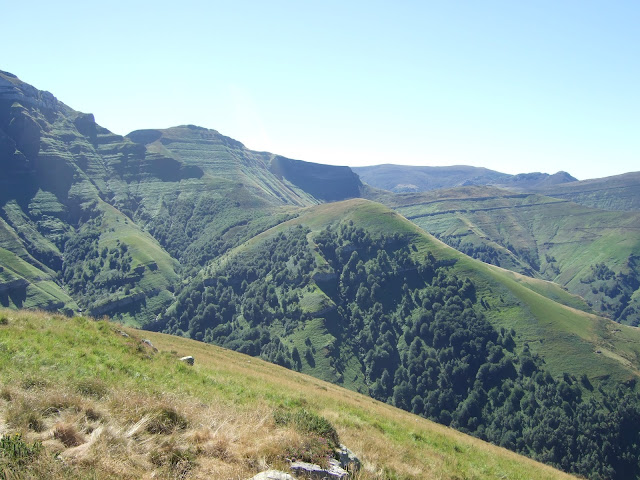"No hay mal que por bien no venga" ha sido uno de los primeros refranes españoles que aprendí. Desde luego puede aplicarse al día que fui a Vega de Pas pensando subir por el km vertical. Al encontrar la carretera cerrada en Portilla (y sin ningún tipo de indicación en la página web de la DGT) tuve que replantear mi idea. Por suerte vi una indicación de la ruta Portilla - Aguasal (PR S 63) y ya que había cobertura en la zona pude descargar un track de esta ruta.
Si no hubiera sido por las obras no habría descubierto esta ruta tan bonita que traza un recorrido similar al del kmV ya que se dirige hacia Castro Valnera pero acaso con mayor variedad de paisajes.
Every cloud has a silver lining, as they say. This definitely applied the day I was prevented from doing the hike I'd planned due to the approach road being closed. Fortunately I saw signposts for a different walk, which turned out to be a great alternative.
Para empezar, una subida suave por Los Perales - un bosque de robles y hayas
To begin with, a gentle walk up through oak and beech woods
Al salir del bosque sigo la ascensión tranquila de cabaña en cabaña, disfrutando de las vistas de los montes y valles que me rodean. Ya se ven por ejemplo los Picones de Sopeña, enmarcados en la ventana de una cabaña abandonada
When I came out of the woods the ascent took me past the stone huts typical of the Pas valleys. Some are abandoned, like this one - what used to be a window framed the nearby Picones de Sopeña range
Carrying on upwards, Castro Valnera mountain comes into view - later I'll be going down towards the right and will see it in more detail
Aunque los praos no se ven muy verdes hacia el norte, las estribaciones de los picones sí lo están
Although the meadows to the north aren't very green, the spurs coming down from the mountains look as I remember them to have been
Dejo la bajada para más tarde y subo un poco más hasta el Cueto de Hormías, delante de la Len Hermosa y el Picón de los Lastreros - hace ¡12 años! que no andaba por esa zona
I leave the descent for later and continue on up to a vantage point right in front of the Len Hermosa (beautiful slope) and another summit to the right I hadn't been to for 12 years
A la izquierda el Coterón
The continuation to the left
Looking towards the right. That's where the planned walk for the day would have taken me. I decide to walk down a bit to get a better view.
y ver mejor la majestuosidad de Castro Valnera
and see Castro Valnera in all its majesty
De vuelta a la colina desde donde podré retratar buena parte de la subida hecha
Back up to the hill where I'll be able to see a good part of the walk I did earlier on
esta es la lengua verde por la que subí. Ahora bajaré un poco para girar hacia la izquierda y reencontrarme con el PR.
So this is the gentle ridge I walked up. I'll now go down past the cattle and follow a signpost down to the left
Vamos para abajo pero ¡no tan directamente!
I'll be going down to the river but not so directly!
Un sendero nos llevará desde la parte baja de este prao por los helechos hasta el fondo del valle. Me alegra ver que hay algo de agua en la cascada de la Canal de la Vara
From the bottom of this meadow a path takes me down past the bracken to the foot of the valley. I'm happy to see the waterfall is visible
aquí está con zoom - serán los dos días de agua que proporcionan el chorrito
Here's a close-up - two days of rain mean at least there's a trickle of water
Bajamos en zigzag hasta las cabañas abandonadas que se ven a la derecha
Zigzagging my way down to the abandoned huts down to the right
No resisto a subir otra foto de una de mis dos montañas favoritas de Cantabria
I can't resist posting another photo of one of my favourite mountains in Cantabria
Una visita a las praderas de Aguasal. No voy muy lejos porque aprieta el calor. Cuando vine por aquí por primera vez seguí hasta la cascada
A visit to the Aguasal pastures. I don't follow the stream for long though as it's getting pretty warm. The first time I came to this spot I carried on as far as the waterfall
Los colores de ¿un otoño adelantado?
Looks like autumn might be earlier this year
Bajo hasta el río y pronto llego a La Estribera - donde quería haber aparcado por la mañana. Pero ya que la carretera está cerrada me quedan 4 kilómetros de asfalto hasta llegar al coche. Por lo menos él de la excavadora paró un momento para dejarme pasar.
Pues lo dicho; posiblemente no hubiera descubierto esta ruta si no fuera por la obra - a pesar del tramo final por la carretera me ha parecido preciosa.
I go back to the main route and carry on down to the river, soon reaching La Estribera, which is where I would have set off from if I'd been able to drive there that morning. So I'm left with 4 kms along the road to get to the car. At least the guy operating the excavator stopped a moment to let me get by.
As I said before, if it hadn't been for the roadworks I might never have discovered such a lovely walk, the last section notwithstanding.
Por último, la cascada como la veía en abril del 2008
Finally, the waterfall as I saw it in April 2008




































